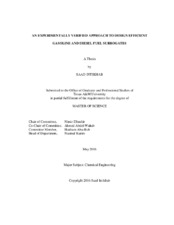| dc.description.abstract | Gasoline or diesel fuel sourced from crude oil source is a complex mixture of hundreds of hydrocarbons. It is extremely difficult to simulate for better understanding of the fuel flow and combustion behaviors which are essential to enhance fuel quality and to improve engine performance. To overcome this difficulty, a surrogate fuel, that has fewer compounds and that emulates certain important physical properties of a target fuel, can be utilized.
The surrogate mixtures for both gasoline and diesel are designed through a computer aided model based technique by our collaborator at Technical University of Denmark (DTU), and their relevant target properties are predicted. Following the preparation of surrogate blends, target physical properties of both fuel surrogates are measured according to American Society of Testing and Materials (ASTM) methods using advanced analytical equipment in the Fuel Characterization Laboratory.
For both gasoline and diesel surrogates, the model predictions are found to be in good agreement with the experimental results except for a few reported cases such as the Reid Vapor Pressure (RVP) of gasoline. For such cases, modifications are made to the model in order to improve the predicted results. Therefore, the experimental investigations are found to be extremely essential for improving the assumptions used to define interactions of the hydrocarbons in the mixtures, which in turn enables enhanced predictability of the model.
The developed model, which leads to a property driven product, can be further investigated to prepare new fuel blends and identify suitable renewable additives in a known amount that can aid in designing of future generation of fuels obtained from either conventional crude oil sources or non-conventional sources. Even though this model provides an excellent, fast and reliable opportunity for screening large number of fuel surrogates and optimization of the same, it is extremely important to experimentally verify the final blends and fine-tune them if necessary before their utilization in engine. Also, the measured property values help to improve the accuracy of the property models as well as the assumptions used to develop them. | en |


